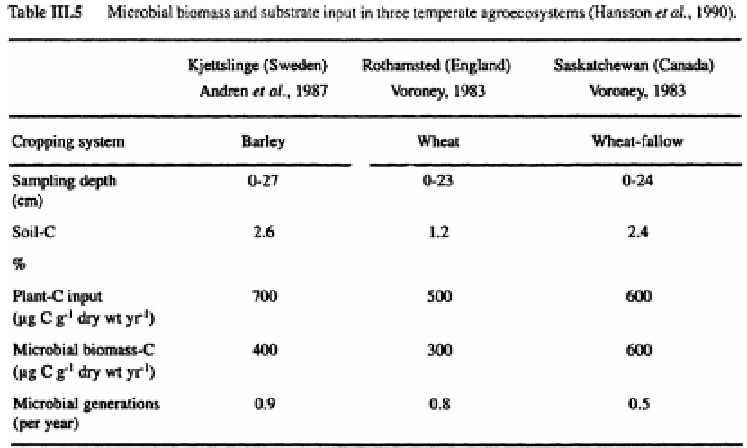Agriculture Reference
In-Depth Information
Mt Popocatepetl (Mexico), clear seasonal variation has been observed in the composition
and abundance of fungal communities, especially at high altitudes (3660 m) (Bettucci
et al.,
1990). In temperate forest ecosystems, fungal activity, as measured by the growth
of mycelium on buried nylon gauze, was at a maximum in Spring, early Summer and
Autumn although no significant change in the amount of live hyphae was observed
(Nagel de Boois 1971; Cancela da Fonseca, 1975; Tôth and Hammer, 1977). Nonetheless,
significant differences have been observed in the growth of mycelia in litter of contrast-
ing quality,
i.e., Pinus sylvestris
and
Carpinus betulus
(Garay, 1989).
2.4.3
TURNOVER OF MICROBIAL BIOMASS: THE SLEEPING BEAUTY
PARADOX
The turnover time of microbial biomass has been estimated in a limited number of soils
by comparing the average microbial biomass to plant-C input to the system, assuming
that the production of microbial biomass is equivalent to 50 % of the organic inputs to
the soil (Table III.5).
Jenkinson and Ladd (1981) used a mathematical model to calculate generation
intervals of 912 and 456 days in, respectively, English and Australian soils. Chaussod
et al.,
(1988) gave similar estimates of 522-659 days in cultivated fields near Paris,
although, under laboratory conditions (28 °C at field capacity over 56 days), the turnover
time decreased to 133-179 days. Turnover time may however be significantly greater in
soils that experience thermic or hydric stresses, especially those with a sandy texture.
For example, turnover time of the microbial biomass was estimated at 1600 days
in Saskatoon (Canada), 570 days at Rothamsted (England) and 460 days in Brazil
(Paul, 1984).

